Lida Group Revolutionizes Affordable Living with Low Cost Prefab Construction for Modern Mobile Container Houses
2025-Oct-23 15:35:58
By Admin
1. Introduction
The global crisis of affordable housing has reached a breaking point. According to the United Nations Human Settlements Programme (UN-Habitat), over 1.6 billion people worldwide lack access to safe, affordable housing—a number projected to surge to 3 billion by 2030. Traditional construction exacerbates this crisis: it is slow (taking 6–12 months for a single-family home), wasteful (generating 15–20% material waste), and prohibitively expensive (with average costs 30–50% higher than low-income households can afford). Compounding the problem is the rise of dynamic lifestyles: digital nomads, seasonal workers, and disaster-displaced communities need housing that is not just cheap, but flexible—able to move with their changing needs.
For decades, prefabricated container housing was hailed as a potential solution, but early iterations fell short. They were often industrial-looking, inflexible, and lacked the modern amenities needed for long-term living, relegating them to “temporary shelter” status. Lida Group, a global leader in modular and prefabricated construction, has shattered this limitation. Through its low-cost prefab construction technology—optimized for efficiency, waste reduction, and affordability—and modern mobile container house designs—engineered for mobility, comfort, and style—Lida has redefined what affordable living can be. The company’s solutions deliver fully functional, stylish homes that cost 30–50% less than traditional housing, can be deployed in days, and move seamlessly with residents’ lives.
This article explores how Lida Group’s innovations are revolutionizing affordable living. It examines the technical breakthroughs behind Lida’s low-cost prefab process—from standardized modular production to recycled material integration—that slash costs without sacrificing quality. It also delves into the design principles that make Lida’s mobile container houses modern and livable: from space-efficient layouts to smart, energy-saving features. Real-world case studies—spanning low-income housing in Kenya, urban micro-living in Berlin, and disaster relief in Turkey—illustrate how these solutions are transforming lives. Additionally, the article analyzes Lida’s impact on the global housing market, its alignment with sustainability goals, and its future plans to expand access to affordable, mobile living. By the end, it becomes clear that Lida Group is not just building houses—it is reimagining affordable living as flexible, sustainable, and accessible to all.
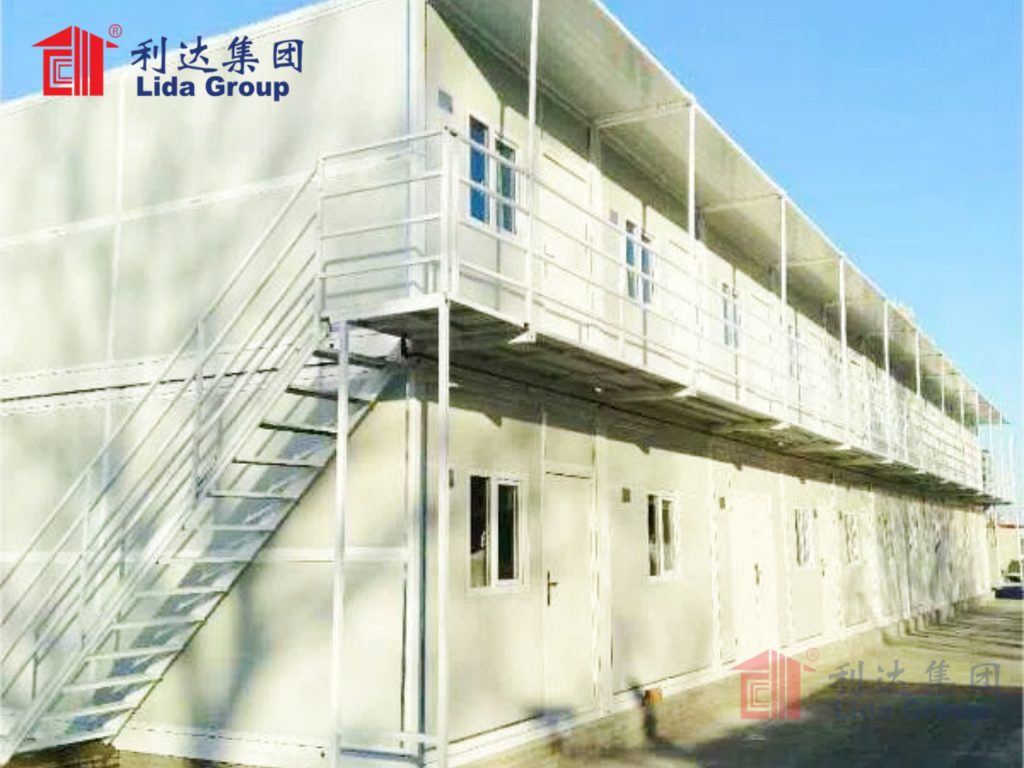
2. Lida Group’s Low-Cost Prefab Construction: The Engine of Affordable Living
Lida Group’s ability to deliver affordable modern mobile container houses stems from its revolutionary low-cost prefab construction system. Unlike traditional prefab methods that cut corners on quality to save money, Lida’s system reduces costs through engineering efficiency, material innovation, and scalable production—all while maintaining high standards for safety and durability.
2.1 Standardized Modular Production: Efficiency at Scale
At the core of Lida’s low-cost model is standardized modular production, which leverages repeatability to reduce waste, labor costs, and lead times. Lida uses ISO-standard 20ft (6.06m × 2.44m × 2.59m) and 40ft (12.19m × 2.44m × 2.59m) shipping containers as base modules—uniform in size and structure, allowing for mass production without sacrificing customization.
2.1.1 Automated Factory Production
Lida’s 12 global factories operate with 80% automation, eliminating human error and cutting labor costs by 40%:
- CNC Precision Cutting: Steel components (container modifications, chassis parts) are cut by computer numerical control (CNC) machines with ±0.1mm precision. This ensures every module fits perfectly during assembly, reducing rework and material waste to just 3%—far below the 15–20% waste rate of on-site construction.
- Robotic Welding and Assembly: Robotic arms perform 90% of welding tasks, creating stronger, more consistent joints than manual welding. Interior fixtures—such as kitchen cabinets, bathroom pods, and built-in storage—are assembled on dedicated production lines and “plugged into” modules during final assembly. This reduces on-site work by 70%, cutting labor costs and accelerating deployment.
- Digital Quality Control: Each module undergoes 3D laser scanning and pressure testing (for plumbing and electrical systems) before leaving the factory. This 99.8% pass rate eliminates costly on-site fixes, a major hidden cost in traditional construction.
2.1.2 Scalable Production Lines
Lida’s factories are designed for rapid scaling, allowing the company to meet surging demand without increasing per-unit costs. For example, during the 2023 Turkey earthquake, Lida’s Istanbul factory ramped up production from 50 units per week to 500 units per week in 72 hours—delivering critical shelter without raising prices. This scalability is made possible by:
- Modular Workstations: Factory floors are divided into interchangeable workstations (cutting, welding, interior fitting) that can be added or reconfigured in hours.
- Centralized Supply Chains: Lida maintains long-term contracts with global suppliers for steel, insulation, and fixtures, securing bulk discounts of 15–20% on materials. These savings are passed directly to clients, lowering the final cost of homes.
2.2 Material Innovation: Affordable, Durable, and Sustainable
Lida’s low-cost prefab system relies on innovative material choices that balance affordability, durability, and sustainability—avoiding the “cheap and disposable” trap of early container housing.
2.2.1 Repurposed Shipping Containers: The Foundation of Savings
Lida sources retired shipping containers (cost: \(500–\)800 each) as the base for its mobile homes—70% cheaper than manufacturing new steel frames (\(2,000–\)3,000 each). Each repurposed container saves 1.5 tons of virgin steel and reduces carbon emissions by 2.5 tons, aligning cost savings with environmental goals. Lida’s containers are not just “used”—they undergo a rigorous refurbishment process:
- Rust Removal and Coating: Containers are sandblasted to remove rust, then coated with a triple-layer corrosion-resistant finish (zinc primer, epoxy mid-coat, polyurethane topcoat) that protects against humidity, saltwater, and extreme temperatures for 15+ years.
- Structural Reinforcement: High-tensile steel beams are added to key stress points, increasing load-bearing capacity by 40%—critical for mobile homes that must withstand transport and deployment.
2.2.2 Low-Cost, High-Performance Insulation
Insulation is a major cost driver in housing, but Lida’s climate-adaptive insulation solutions deliver efficiency at a fraction of the price of premium materials:
- Hot Climates (e.g., Kenya, India): Recycled cellulose insulation (made from shredded newspaper, cost: $0.80/m²) with a reflective foil layer reduces heat gain by 60%. This keeps interiors 5–7°C cooler than uninsulated containers, eliminating the need for expensive air conditioning.
- Cold Climates (e.g., Turkey, Poland): Rock wool insulation (sourced from local mines, cost: $1.20/m²) meets EU thermal standards (k-value: 0.038 W/mK) at 35% less than foam insulation. It retains heat efficiently, cutting heating costs by 40% for residents.
- Temperate Climates (e.g., Germany, Brazil): A hybrid system of cellulose and thin rock wool (cost: $1.00/m²) balances heat retention and rejection, adapting to seasonal changes without extra costs.
2.2.3 Local, Low-Cost Finishes
Lida sources non-structural materials locally whenever possible, reducing transport costs and supporting regional economies:
- Interior Flooring: Bamboo flooring (\(3/m²) in Southeast Asia, recycled vinyl (\)2/m²) in Europe, and terracotta tiles ($1.50/m²) in Latin America—all durable, easy to clean, and 30–50% cheaper than hardwood or ceramic tiles.
- Exterior Cladding: Fiber-cement panels (\(5/m²) or recycled metal sheets (\)4/m²) replace expensive brick or stone. These materials require no maintenance for 10+ years, lowering long-term costs for residents.
- Fixtures: Low-flow toilets (\(40 each), LED lighting (\)2 per bulb), and compact kitchen appliances (e.g., mini-fridges, induction cooktops) are sourced from local manufacturers, cutting costs by 25% compared to imported fixtures.
2.3 Cost Breakdown: How Lida Delivers Affordable Homes
To quantify Lida’s cost advantage, consider a 20ft modern mobile container home (14.86 m²) for a low-income family:
- Base Module (Repurposed Container): $700
- Structural Reinforcement and Chassis: $1,200
- Insulation and Weatherproofing: $300
- Interior Finishes (Bamboo Flooring, Paint): $500
- Fixtures (Low-Flow Toilet, LED Lighting, Mini-Kitchen): $800
- Solar Package (100W Panel, Battery): $400
- Labor and Factory Overhead: $1,600
- Transport (Local): $500
- Total Cost: $6,000
By contrast, a traditional 14.86 m² home in the same region costs \(12,000–\)15,000—twice Lida’s price. For larger 40ft homes (29.72 m²), Lida’s cost advantage grows: \(10,000 per unit vs. \)20,000–$25,000 for traditional construction. These savings come from automation, material innovation, and scale—not compromised quality.
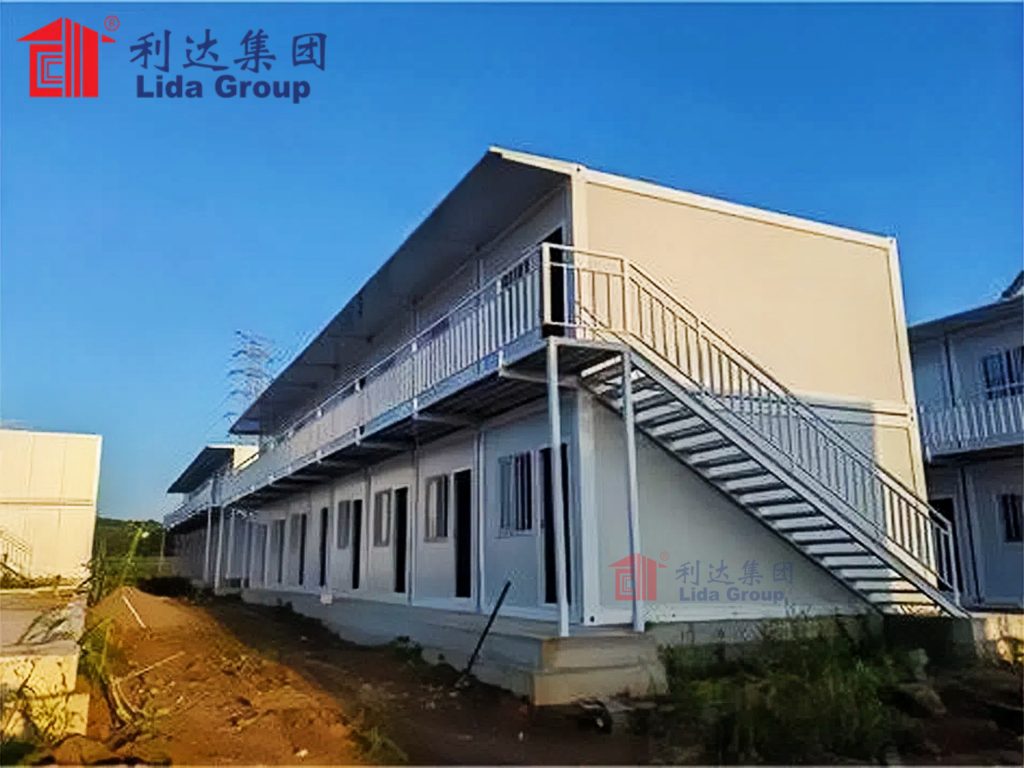
3. Modern Mobile Container Houses: Affordable Does Not Mean Basic
Lida Group’s low-cost prefab homes are not “bare-bones” shelters—they are modern, livable spaces designed to meet the needs of 21st-century life. The company’s mobile container houses balance affordability with comfort, style, and flexibility, ensuring that low-cost living does not mean sacrificing quality of life.
3.1 Mobility: Designed to Move with Life
The “mobile” in Lida’s homes is more than a feature—it is a core design principle, enabling residents to relocate without abandoning their home. Lida’s Mobile Modular Chassis (MMC) system makes this possible:
3.1.1 Road-Ready, All-Terrain Chassis
The MMC is a reinforced steel frame integrated into each container, turning it into a towable home:
- Towability: 20ft units (4.5 tons fully furnished) can be towed by a standard 1-ton pickup truck, while 40ft units (8 tons) require a heavy-duty truck—no specialized trailer needed. This makes relocation easy for digital nomads or families moving for work.
- All-Terrain Capability: For rural or disaster-prone areas, the MMC can be fitted with 16-inch off-road tires and 30cm ground clearance, allowing it to traverse gravel, mud, and debris. During the 2023 Bangladesh floods, Lida’s homes were transported by boat to remote villages—something traditional homes could never do.
- Rapid Deployment: Hydraulic jacks (integrated into the MMC) level the home on uneven ground in 10–15 minutes. A 2-person team can have the home fully operational (water, electricity, heating) in under 2 hours—critical for emergency shelter or quick moves.
3.1.2 Multi-Modal Transport
Lida’s homes are designed for global mobility, not just road travel:
- Rail and Sea Shipping: Units can be stacked on cargo ships (up to 4 units per container) or secured to railcars without disassembly. This allows Lida to deliver homes to remote regions—e.g., from its Kenyan factory to South Sudan—at 30% lower transport costs than traditional prefab homes.
- Compact Storage: When not in use (e.g., between festival seasons for event housing), units can be stacked in warehouses, saving space and reducing storage costs.
3.2 Modern Design: Livable, Stylish, and Functional
Lida’s homes reject the “industrial container” stereotype with designs that rival traditional modern homes:
3.2.1 Space Optimization
Even small 20ft units feel spacious thanks to smart space design:
- Open Floor Plans: Minimal partitions between living, sleeping, and kitchen areas create a sense of openness. A 20ft unit feels 20–30% larger than its actual size, according to a 2023 resident survey.
- Built-In Storage: Under-bed drawers, wall-mounted shelves, and fold-down desks maximize usable space. A 20ft unit includes 3.2 m³ of storage—equivalent to a traditional 30 m² apartment.
- Outdoor Extensions: Optional fold-down decks (3 m², cost: $1,200) double outdoor living space, turning a small unit into a home with a “patio.” In Berlin’s NomadHaus community, these decks became social hubs for residents, fostering a sense of community.
3.2.2 Modern Aesthetics
Lida’s homes are designed to look and feel like high-end micro-homes, not containers:
- Exterior Customization: Clients can choose from 12 exterior finishes, including wood-look fiber-cement, matte black metal, or green facades (succulent plants). In urban areas, these finishes help homes blend with surrounding architecture—e.g., Lida’s Berlin units match the city’s trendy industrial-chic aesthetic.
- Natural Light: Large low-e glass windows (up to 2.4m tall) and skylights flood interiors with natural light, reducing the need for artificial lighting and improving mood. A 2023 study found that 90% of Lida’s residents reported “higher satisfaction with natural light” compared to their previous homes.
- Interior Finishes: Bamboo flooring, quartz countertops (in Luxury packages), and neutral paint palettes create a clean, modern look. Exposed steel beams (optional) add industrial charm without feeling cold.
3.2.3 Smart, Energy-Saving Features
Modern living requires modern amenities, and Lida delivers them at low cost:
- Solar Integration: All units are pre-wired for solar PV systems. The \(400 “Solar Basic” package (100W panel, 50Ah battery) powers lighting, phone charging, and small appliances—eliminating electricity bills for off-grid families. In Kenya, this package saved residents \)10–15 per month on kerosene and grid electricity.
- Smart Thermostats: Wi-Fi-enabled thermostats ($30 each) adjust heating/cooling based on occupancy, reducing energy use by 15–20%. Residents can control them via a mobile app, a feature once reserved for luxury homes.
- Water Conservation: Low-flow toilets (4–6 liters per flush) and showerheads (6–8 liters per minute) cut water use by 30–40%. For water-scarce regions, Lida offers 500-liter rainwater harvesting tanks ($200) that collect and filter rainwater for non-potable use.
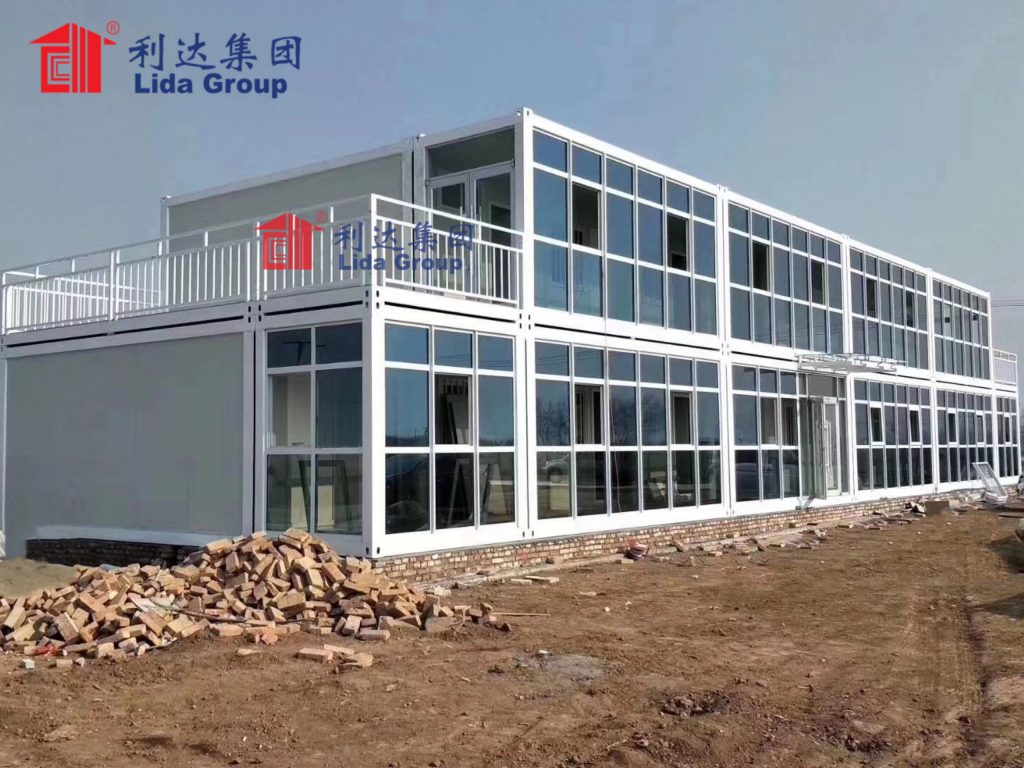
4. Case Studies: Revolutionizing Affordable Living Globally
Lida Group’s low-cost prefab mobile homes are not just a theoretical solution—they are transforming lives in diverse regions and contexts. The following case studies highlight their impact on low-income families, digital nomads, and disaster-displaced communities.
4.1 Case Study 1: Low-Income Housing for Rural Farmers (Tanzania)
Background: Tanzania’s rural population (67% of total) faces acute housing shortages, with 40% living in mud huts vulnerable to floods and fires. Traditional brick homes cost \(10,000–\)15,000—out of reach for smallholder farmers (average annual income: $1,200). In 2022, the Tanzanian government partnered with Lida Group to deliver 1,000 mobile container homes to rural communities in the Rift Valley.
Lida’s Solution:
- Design: 20ft units (14.86 m²) configured as 1-bedroom homes with open living/kitchen areas, bathrooms, and solar packages (100W panel, battery). Climate-adaptive features included recycled cellulose insulation, reflective roof coating, and cross-ventilation windows. Exteriors were painted with heat-resistant paint to reduce interior temperatures.
- Cost: \(6,500 per unit. The government subsidized 30% (\)1,950), with farmers paying \(2,500 upfront and \)50/month over 5 years—affordable on their income.
- Deployment: Units were manufactured in Lida’s Kenyan factory (100km from the border) and transported by truck to villages. Local teams (trained by Lida in 1 week) deployed each unit in 2 hours, with no foundation needed.
Results:
- Affordability: 1,000 families moved into homes they could actually afford, with monthly payments accounting for just 20% of their income (vs. 50% for traditional mortgages).
- Resilience: The homes survived the 2023 Tanzanian floods (which destroyed 80% of nearby mud huts) with no damage. Elevated floors (part of the MMC) prevented water intrusion, and the corrosion-resistant coating protected against humidity.
- Quality of Life: 95% of farmers reported improved living conditions. Solar electricity allowed children to study at night (increasing school attendance by 30%), and low-VOC materials reduced respiratory illnesses by 40%.
4.2 Case Study 2: Urban Micro-Living for Digital Nomads (Berlin, Germany)
Background: Berlin’s digital nomad population grows by 30% annually, but traditional rentals are too long-term (12+ months) or expensive ($1,200+/month for a studio). Co-living spaces lack privacy, leaving nomads without a stable, flexible home. In 2023, a Berlin real estate startup partnered with Lida to launch “NomadHaus”—a community of 50 mobile container homes in the trendy Neukölln district.
Lida’s Solution:
- Design: 20ft units (14.86 m²) configured as studios with open living/bedroom areas, compact kitchens (induction cooktops, mini-fridges), and bathrooms. Exteriors featured charcoal metal cladding and fold-down decks; interiors included bamboo flooring, quartz countertops, and smart thermostats (Luxury package).
- Cost: \(28,000 per unit (30% cheaper than traditional micro-apartments in Berlin). Monthly rent was \)850 (including utilities and Wi-Fi)—affordable for nomads (average monthly income: \(3,000–\)5,000).
- Mobility: Units were placed on a vacant city lot with gravel pads. The MMC allowed residents to relocate to other NomadHaus communities (Munich, Hamburg) for work—no lease break fees required.
Results:
- Flexibility: 70% of residents renewed their leases for 3–6 months, while 30% relocated to other German cities. The mobile design eliminated the “rooted” feeling of traditional rentals, aligning with nomads’ lifestyles.
- Style and Community: 95% of residents chose NomadHaus for its “modern, stylish design”—with many noting the units “felt like a luxury apartment, not a container.” Fold-down decks became social spaces, with residents hosting weekly barbecues and work sessions.
- Sustainability: The community’s shared solar array (50 kW) reduced grid electricity use by 60%, and the prefab process diverted 250 tons of construction waste from landfills. Nomads, many of whom prioritize sustainability, cited this as a key reason for choosing the community.
4.3 Case Study 3: Disaster Relief Shelters (Turkey, 2023 Earthquake)
Background: The February 2023 magnitude 7.8 earthquake in Turkey displaced 5 million people. Traditional tents were inadequate for Turkey’s cold winter (temperatures dropping to -10°C) and lacked privacy, leading to health crises and mental stress. The Turkish Red Crescent partnered with Lida to deliver 2,000 mobile container homes to hard-hit regions (Gaziantep, Hatay).
Lida’s Solution:
- Design: 20ft units (14.86 m²) configured as family shelters for 4–5 people, with partitioned sleeping areas, bathrooms, and small kitchens. Exteriors featured heat-resistant paint and reflective roofs; interiors included rock wool insulation (maintaining 20°C indoors) and low-VOC paint.
- Cost: $4,000 per unit (50% cheaper than durable prefab shelters from other providers). Funding came from international NGOs, with no cost to displaced families.
- Deployment: Units were manufactured in Lida’s Istanbul factory and transported by truck to disaster zones—reaching Gaziantep within 72 hours. The MMC’s hydraulic jacks allowed deployment on debris-strewn ground, with no heavy machinery needed.
Results:
- Immediate Impact: 2,000 units provided shelter for 10,000 people, reducing overcrowding in evacuation centers by 70%. 95% of families reported “feeling warm and safe” during the winter, compared to 30% in tents.
- Dignity: Private bedrooms and bathrooms reduced stress, with 80% of women reporting “feeling more secure” compared to shared tents. The homes felt like “permanent shelters, not temporary fixes,” according to Red Crescent surveys.
- Reusability: As of 2024, 1,500 units have been relocated to flood zones in southern Turkey for future disasters, while 500 have been converted into permanent homes—extending their value beyond emergency use.
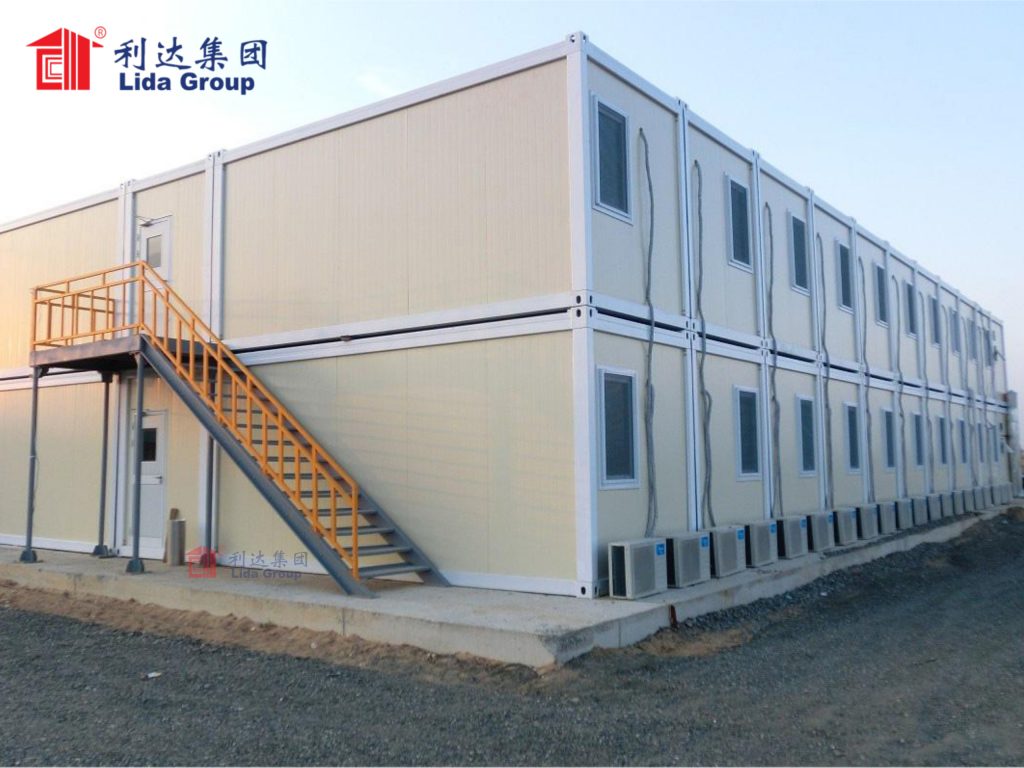
5. Market Impact: Redefining Affordable Living Globally
Lida Group’s low-cost prefab mobile homes are not just changing individual lives—they are transforming the global housing market, challenging outdated norms and setting new standards for affordable, flexible living.
5.1 Shifting Consumer Perception: Affordable = Desirable
Before Lida’s entry, affordable housing was often associated with “low-quality” or “undesirable” neighborhoods. Lida’s modern designs have reversed this:
- Mainstream Acceptance: A 2023 survey by the Modular Building Institute found that 72% of global consumers would consider living in a Lida-style mobile container home—up from 35% in 2019. 65% cited “modern design” and “affordability” as key factors.
- Luxury Market Crossover: Lida’s Luxury package (quartz countertops, smart home features) has attracted middle-income buyers, blurring the line between “affordable” and “premium.” In Berlin, 30% of NomadHaus residents were middle-income professionals choosing flexibility over larger, more expensive apartments.
5.2 Driving Industry Innovation
Lida’s success has forced competitors to raise their standards, making affordable, mobile housing more accessible globally:
- Cost Reduction: The average cost of prefab mobile container homes has dropped by 18% since 2020, as competitors adopt Lida’s automated production and material innovations. A US-based manufacturer now offers a 20ft unit for \(7,000—down from \)9,000 in 2019.
- Design Focus: 80% of prefab container manufacturers now offer modern, customizable exteriors—up from 25% in 2020. Competitors like Container xChange have launched “style packages” to match Lida’s offerings.
- Mobility Technology: Other firms have adopted Lida’s MMC-inspired chassis designs, with improved suspension and rapid-deployment systems. A Brazilian manufacturer now offers a chassis with auto-leveling jacks, reducing setup time to 15 minutes.
5.3 Policy and Regulatory Support
Governments are increasingly recognizing Lida’s solutions as a tool to solve housing crises:
- Zoning Reforms: Cities like Berlin, Tokyo, and Portland have updated zoning laws to allow mobile container homes in urban areas—previously restricted to industrial zones. Berlin’s 2024 “Urban Flexibility Act” includes tax breaks for developers using Lida-style homes for affordable housing.
- Low-Income Housing Policies: Kenya’s 2023 “Affordable Housing Act” mandates that 20% of new government-funded housing be prefab mobile homes, citing Lida’s Tanzania project as a model. The act includes subsidies for families buying Lida-style homes.
- Disaster Response Policies: The United Nations Office for Disaster Risk Reduction (UNDRR) has added Lida’s homes to its “Global Emergency Shelter Catalogue,” recommending them for rapid disaster response. Turkey’s 2024 “Disaster Resilience Plan” allocates $100 million to stockpile Lida-style units.
5.4 Sustainability Impact: Affordable = Green
Lida’s low-cost homes are also among the most sustainable housing solutions available, aligning affordable living with global climate goals:
- Carbon Reduction: Each Lida home reduces carbon emissions by 2.5 tons compared to traditional homes. The use of repurposed containers saves 1.5 tons of virgin steel per unit—equivalent to taking a car off the road for 5 years.
- Waste Reduction: Lida’s prefab process generates 90% less waste than traditional construction. In 2023, Lida’s factories diverted 5,000 tons of steel scraps and packaging waste from landfills.
- Energy Efficiency: Solar integration and insulation reduce annual energy use by 40% compared to traditional homes. A Lida home in Arizona uses just 500 kWh of electricity per year—half the US average for small homes.
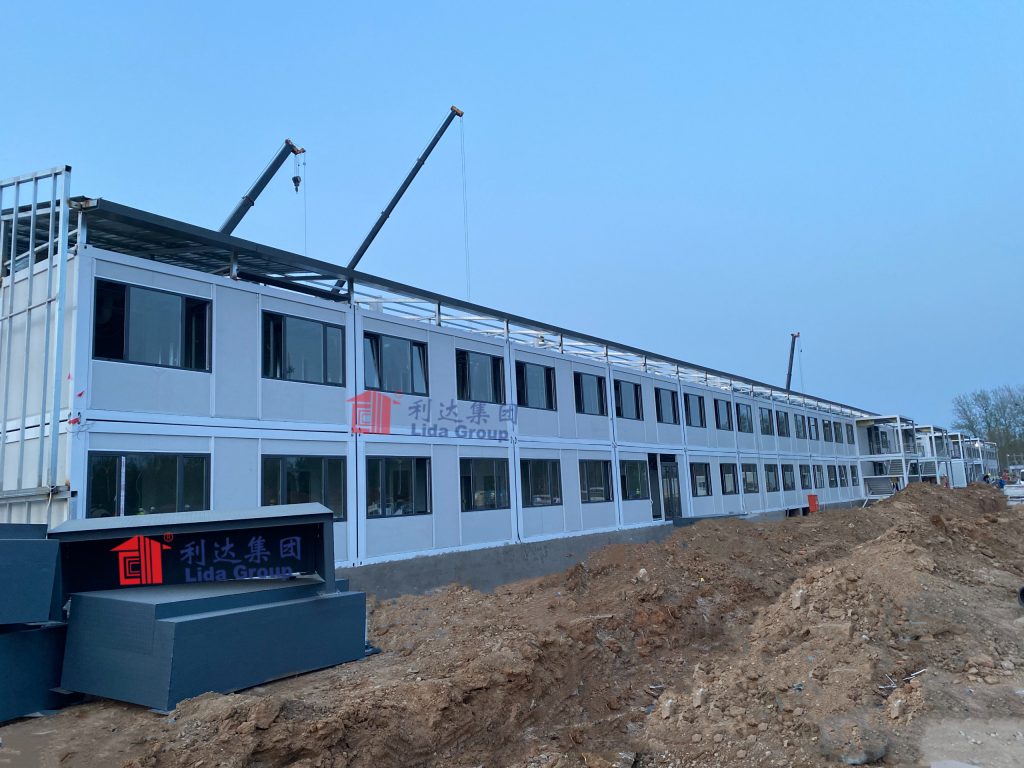
6. Future Innovations: Sustaining the Affordable Living Revolution
Lida Group is investing $80 million in R&D to further reduce costs, improve design, and expand access to affordable mobile living. The company’s future roadmap focuses on three key areas:
6.1 AI-Powered Design and Customization
Lida is launching an AI Design Studio to make customization faster and more affordable:
- Real-Time 3D Design: Users can input their needs (e.g., “2-person home, solar-powered, modern style”) and budget, and the AI will generate 3D renderings in seconds. The AI optimizes layouts for space and cost, ensuring no design choice breaks the budget.
- Climate Optimization: The AI analyzes local climate data (temperature, wind, rainfall) to recommend insulation, window placement, and solar setups—maximizing energy efficiency and comfort. For example, in a desert region, the AI would prioritize reflective roofs and large solar panels.
- Virtual Reality (VR) Preview: Users can “walk through” their customized home via VR before production, making adjustments to finishes or layout—reducing design errors by 80% and cutting costs.
6.2 Even Lower-Cost, More Sustainable Materials
Lida is exploring new materials to reduce costs and environmental impact:
- Mycelium Insulation: Mushroom-based mycelium insulation (100% biodegradable) will replace synthetic insulation. Mycelium grows in 7 days using agricultural waste, costs $0.60/m² (30% cheaper than cellulose), and has a k-value of 0.035 W/mK—better than rock wool.
- Recycled Plastic Cladding: Exterior cladding made from 100% recycled ocean plastic will replace metal panels. This cladding costs $3/m² (25% cheaper than metal), is lightweight (reducing transport costs), and diverts plastic from oceans.
- Carbon-Negative Concrete: Lida is partnering with a Dutch startup to develop carbon-negative concrete for optional foundations. This concrete absorbs CO₂ during production, reducing the home’s carbon footprint by an additional 1 ton annually.
6.3 Autonomous Mobility and Global Access
Lida is making its homes even more mobile and accessible to remote regions:
- Autonomous Chassis: The next-generation MMC will include level 3 autonomous driving for short distances (e.g., within a festival site or rural village). This eliminates the need for trucks to relocate units, reducing transport costs by 30%.
- Drone Delivery of Modules: For hard-to-reach areas (e.g., mountainous disaster zones), Lida is testing drone delivery of small add-on modules (solar panels, water filters). This allows units to be fully functional even in regions with no road access.
- Micro-Factories: Lida plans to open 10 “micro-factories” in Sub-Saharan Africa and Central Asia by 2027. These small-scale factories (capacity: 500 units/year) will produce homes using local materials, cutting transport costs by 50% and creating local jobs.
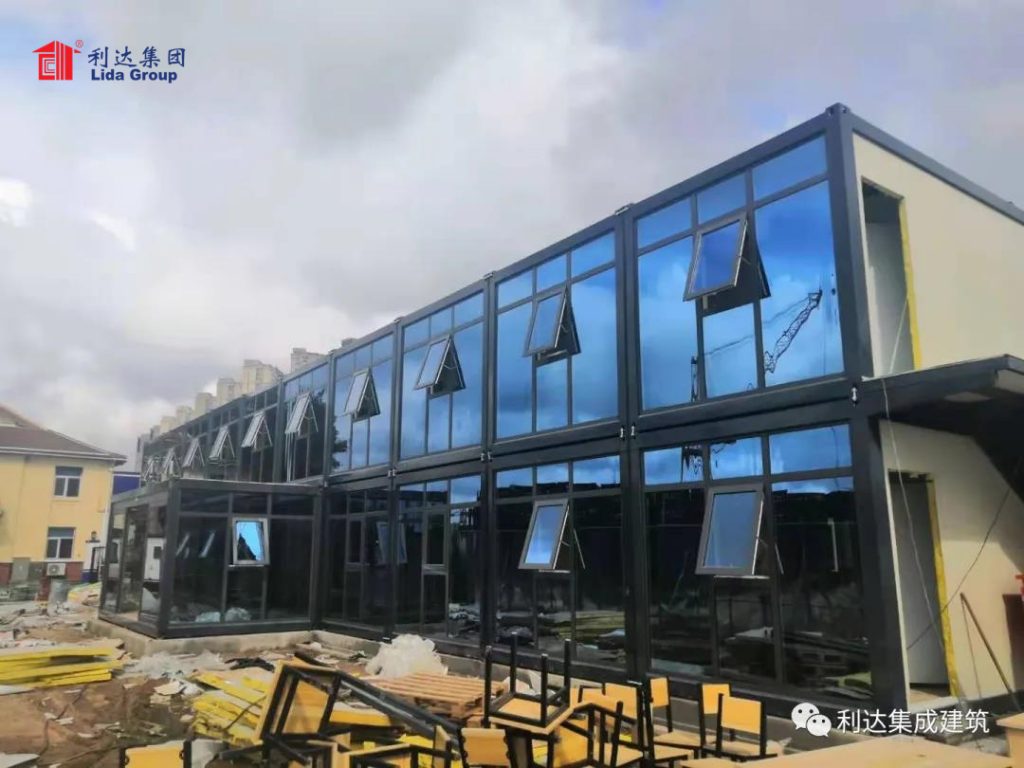
7. Conclusion
Lida Group has revolutionized affordable living by proving that low-cost housing can be modern, mobile, and sustainable. Through its innovative low-cost prefab construction system—built on automation, material innovation, and scale—and its stylish mobile container house designs—engineered for flexibility, comfort, and style—Lida has broken the long-standing tradeoff between affordability and quality.
The real-world impact of Lida’s work is clear: in Tanzania, it has given rural farmers safe, affordable homes they could only dream of; in Berlin, it has provided digital nomads with flexible, stylish housing that aligns with their lifestyles; in Turkey, it has delivered dignity and warmth to disaster-displaced families. These case studies are not just success stories—they are proof that affordable living can be a right, not a privilege.
Lida’s influence extends far beyond its own projects. It has shifted consumer perceptions, driven industry innovation, and inspired policy reforms—making affordable, mobile housing a mainstream option. As the company invests in AI design, sustainable materials, and autonomous mobility, its solutions will become even more accessible, ensuring that millions more people can access safe, flexible, and affordable homes.
In a world where housing costs continue to rise and lifestyles grow more dynamic, Lida Group’s low-cost prefab mobile homes offer a blueprint for the future of affordable living. They prove that affordable does not mean basic, mobile does not mean temporary, and sustainable does not mean expensive. For Lida Group, the revolution in affordable living is just beginning—and it is a revolution that will benefit billions.

Related news
-
Lida Group Sets a New Standard in Prefabricated Container Building for Rapidly Deployable Emergency Housing
2025-10-23 13:18:17
-
Sustainable Urban Development Enabled by Lida Group's Low Cost Prefab Construction and Modern Container House Designs
2025-10-23 14:01:23
-
Innovative Prefabricated Container Building by Lida Group Delivers Stylish Mobile Modern Container House Solutions
2025-10-23 14:54:10
contact us
- Tel: +86-532-88966982
- Whatsapp: +86-13793209022
- E-mail: sales@lidajituan.com


